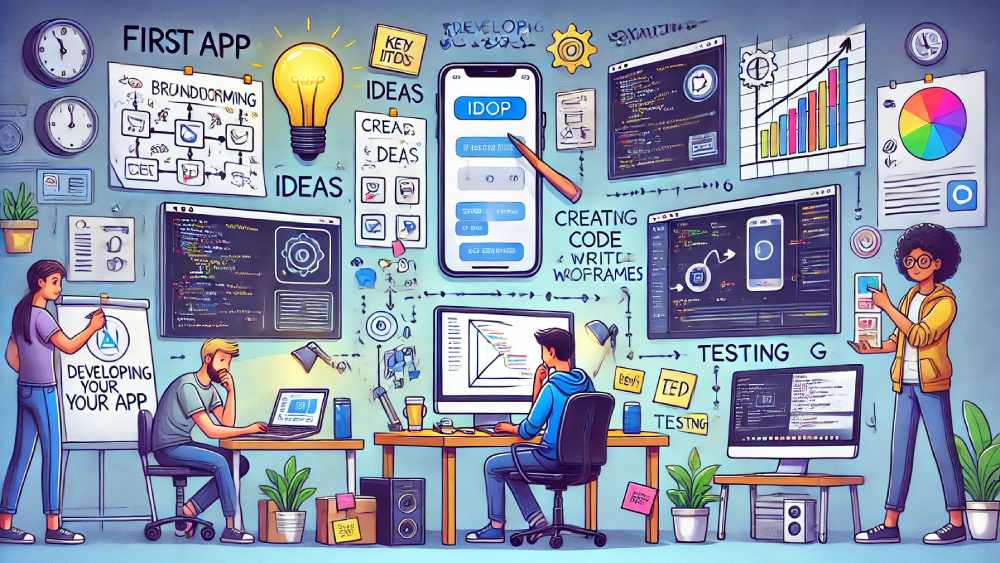A Guide to Building Your First Mobile App
In today’s digital age, mobile apps have become an integral part of our daily lives. From social networking and shopping to fitness tracking and banking, there’s an app for virtually everything. If you’ve ever had a brilliant idea for a mobile app but didn’t know where to start, this guide is for you. Building your first mobile app can be an exciting and rewarding experience. Here’s a step-by-step guide how to develop an app and help you navigate the process from concept to launch.
1. Define Your Idea
The first step in building your mobile app is to clearly define your idea. Ask yourself the following questions:
- What problem does your app solve?
- Who is your target audience?
- What are the key features and functionalities of your app?
- How will your app stand out from the competition?
Example: If your idea is to create a fitness app, define whether it focuses on workout routines, diet tracking, or perhaps a combination of both. Identify your target audience, such as beginners, fitness enthusiasts, or professionals.
2. Conduct Market Research
Before diving into development, conduct thorough market research to validate your idea. Look at similar apps already available and analyze their strengths and weaknesses. Pay attention to user reviews to understand what users like and dislike.
Example: Research popular fitness apps like MyFitnessPal, Nike Training Club, and Strava. Note the features users appreciate and common complaints.
3. Create a Detailed Plan
Once your idea is validated, create a detailed plan outlining your app’s functionality, design, and development process. This plan should include:
- A feature list with descriptions
- User flow diagrams to map out the app’s navigation
- Wireframes to illustrate the app’s layout and design
Example: For a fitness app, list features like workout tracking, progress charts, social sharing, and notifications. Create wireframes showing the home screen, workout logging interface, and profile pages.
4. Choose Your Development Approach
There are several ways to build a mobile app, and your choice depends on your budget, timeline, and technical expertise. The main approaches are:
- Native Development: Building separate apps for iOS (Swift or Objective-C) and Android (Java or Kotlin). This approach offers the best performance but requires more resources.
- Cross-Platform Development: Using frameworks like React Native, Flutter, or Xamarin to build apps for both iOS and Android with a single codebase. This approach saves time and costs.
- No-Code/Low-Code Platforms: Tools like Adalo, Bubble, or Thunkable allow you to build apps without extensive coding knowledge. This approach is ideal for simple apps and prototypes.
Example: If you have a limited budget and need to launch quickly, consider using React Native to develop a cross-platform fitness app.
5. Design Your App
Good design is crucial for the success of your app. It should be visually appealing, user-friendly, and consistent with your brand. Consider hiring a professional designer if necessary. Key aspects of app design include:
- UI (User Interface) Design: Focuses on the look and feel of the app.
- UX (User Experience) Design: Ensures the app is intuitive and easy to use.
Example: For your fitness app, design a clean and motivating interface with easy-to-read fonts, vibrant colors, and intuitive navigation.
6. Develop Your App
With a solid plan and design in place, it’s time to start development. This phase involves writing the code, integrating APIs, and setting up databases. If you’re not a developer, consider hiring one or collaborating with a development team.
Example: For your fitness app, your development tasks might include coding the workout logging feature, integrating with a health API to track progress, and setting up a backend server to store user data.
7. Test Your App
Testing is a critical step to ensure your app functions correctly and provides a good user experience. Perform the following tests:
- Functional Testing: Verify that all features work as expected.
- Usability Testing: Ensure the app is easy to use and navigate.
- Performance Testing: Check the app’s speed and responsiveness.
- Security Testing: Protect user data and ensure the app is secure.
Example: Test your fitness app by logging different workouts, checking progress tracking accuracy, and ensuring that the app performs well under various conditions.
8. Launch Your App
Once your app is thoroughly tested and refined, it’s time to launch. Prepare for submission to the Apple App Store and Google Play Store by following their guidelines. Create a compelling app description, screenshots, and promotional materials.
Example: For your fitness app, highlight its unique features, such as personalized workout plans and progress tracking, in your app store description.
9. Promote Your App
Launching your app is just the beginning. Promote it to reach your target audience and encourage downloads. Use various marketing strategies, including:
- Social media marketing
- Influencer partnerships
- Content marketing (blogs, videos, podcasts)
- App store optimization (ASO)
Example: Create social media accounts for your fitness app and share workout tips, user testimonials, and progress stories to attract and engage users.
10. Gather Feedback and Iterate
After launch, gather user feedback to identify areas for improvement. Regularly update your app to fix bugs, add new features, and enhance the user experience. Engaging with your users and responding to their needs is key to long-term success.
Example: Monitor user reviews for your fitness app, conduct surveys, and implement popular feature requests in future updates.
Conclusion
Building your first mobile app is a challenging but rewarding journey. By following these steps and staying committed to continuous improvement, you can turn your idea into a successful app that users love. Remember, the key to success lies in understanding your audience, creating a well-designed and functional app, and constantly evolving based on user feedback. Happy building!



Post Comment